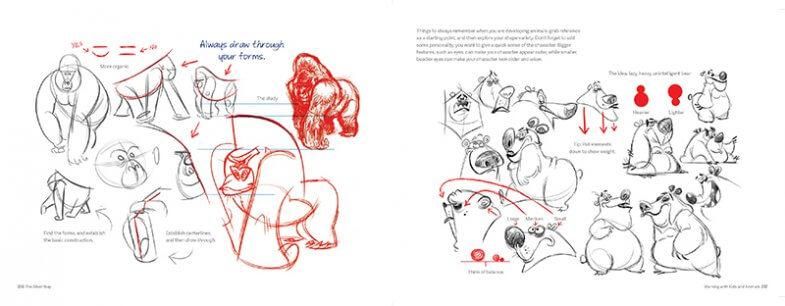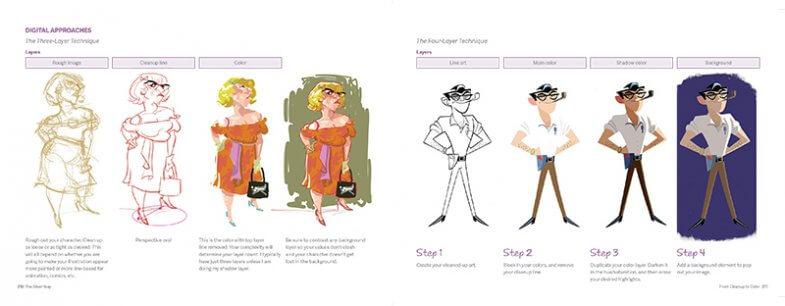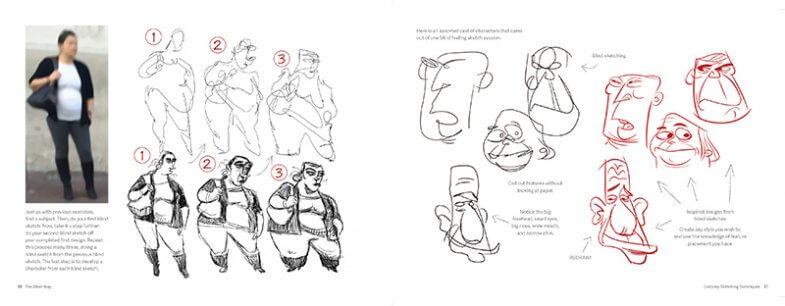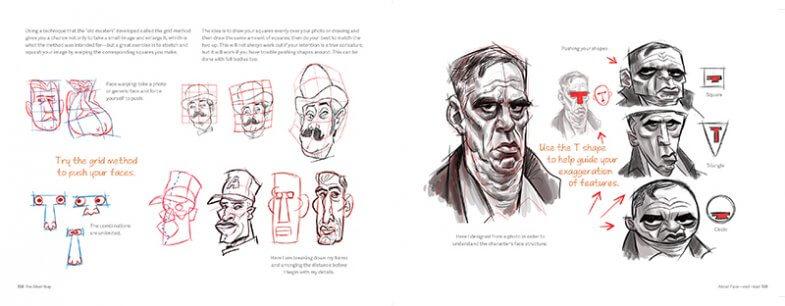Review and Interview: Stephen Silver (‘The Silver Way’)
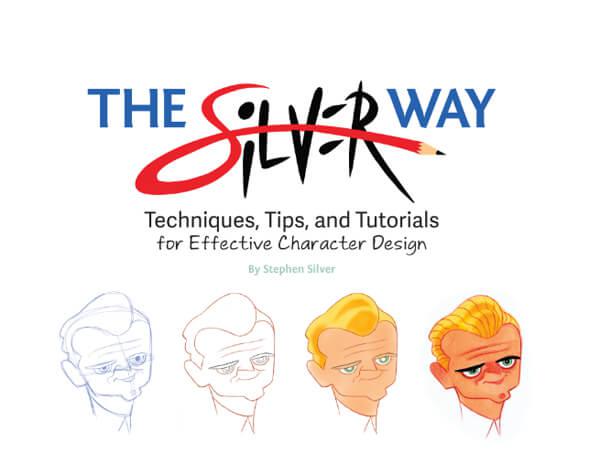 When it comes to the world of character design, Stephen Silver knows his stuff. Not only has his lustrous career seen him working with studios such as Disney and Warner Bros, and as lead character designer on animated shows Kim Possible, Danny Phantom and Clerks: The Animated Series, but he’s also made his name as an incredibly accomplished and passionate teacher. From his weekly YouTube art chats to his Drawing Academy in California, Stephen is dedicated to sharing his valuable experience and knowledge with as many artists as possible – and now, to the delight of creatives worldwide, he’s put everything he knows about character design into book form. The Silver Way: Techniques, Tips and Tutorials for Effective Character Design has officially hit the shelves, and Skwigly relished the chance to review it in depth.
When it comes to the world of character design, Stephen Silver knows his stuff. Not only has his lustrous career seen him working with studios such as Disney and Warner Bros, and as lead character designer on animated shows Kim Possible, Danny Phantom and Clerks: The Animated Series, but he’s also made his name as an incredibly accomplished and passionate teacher. From his weekly YouTube art chats to his Drawing Academy in California, Stephen is dedicated to sharing his valuable experience and knowledge with as many artists as possible – and now, to the delight of creatives worldwide, he’s put everything he knows about character design into book form. The Silver Way: Techniques, Tips and Tutorials for Effective Character Design has officially hit the shelves, and Skwigly relished the chance to review it in depth.
Having never really studied character design before, this Skwigly writer approached The Silver Way a little nervously – would it be accessible enough for even a beginner to follow? The answer is a resounding YES. The Silver Way breaks down the entire process of character design into intensely detailed yet simply explained steps. From the initial inspiration stage all the way to the fully rendered finished artwork, it feels as though every possible nuance of character design is covered – a complete masterclass from the comfort of your armchair.
With over 200 pages packed full of exercises, examples, tips and tricks, The Silver Way will inspire both budding and professional artists, and the sheer volume of information it contains makes it perfect for diving into again and again. The beautiful, glossy spreads are bursting with colour and visuals, prioritising Stephen’s brilliant drawings over unnecessary text to make the theory super clear. The straightforward layout also makes it easy for readers to either work through the whole process from cover to cover, or simply dip into different chapters depending on what stage of the design process they are at. Including practical advice for the professional field, with sections on designing for clients and for the animation industry, The Silver Way is a true character design bible, and a must-have for every artist’s bookshelf.
Skwigly were glad to have a chance to learn more about the book from Stephen himself. Read on as we chat all about his journey to The Silver Way, his most important advice for artists, and things that were just meant to be…
So Stephen, what was your main goal for the book, and what prompted you to want to create it?
My main goal was just education, first. I’ve been teaching for many years now, since 1997 (I think!). I’ve done several of my own published books, but they’ve always been books on just showing my art, and people have always asked me, ‘Hey, when are you going to put out a How To book?’ I knew it would be a big task, but I always had the intention that someday I was going to put together a How To book, and just explain character design in a simple way.
My purpose and passion in life is to teach, and this is why I realised that putting together a book of this magnitude would be ideal. It just felt right. I’m one of those guys who goes where the wind takes me, but I just knew the timing was right, it felt right – and I don’t know why I keep saying that, but it just was! I have so much information, so much to tell, so much to say – this is where it really came from. That’s when I approached Design Studio Press, who have a great volume of art books and tutorials. I showed them some ideas of what I was thinking, they said ‘Yeah, let’s do it!’ and boom, we were just off to the races.
You spoke a little bit about your teaching. With all the different classes you offer – your workshops, your academy, your one-to-one mentoring – you’re clearly a natural teacher. What made you decide to want to teach?
When I was around 6 years old, when I was living in England, I remember looking out of my bedroom window and seeing a book lying in my back yard. I went downstairs and I picked that book up and it was an art book. It had all these artist’s drawings and renderings and portraits… it was kinda crazy, but that’s almost what got me started drawing…
Wow, that’s amazing!
Yeah! So from there I’m drawing drawing drawing, but then through my life, I was always guiding people, I was always helping people naturally – it was just part of who I was. People would always say to me, ‘Hey, you should be a teacher,’ or ‘Thanks so much for your advice,’ or ‘Wow this really helped me,’ and all these little things along the journey kept sort of going in that direction.
I started working in the industry in 1997, working for Warner Bros, and I moved to LA from San Diego, and I was taking some side classes to improve upon my skill. One of my teachers said ‘I don’t know that I can even help you! It’s cool that you’re in here, but you should think about being one of the teachers in my class.’ He said ‘It would make you a better artist, because now you have to break down your theory and your process,’ and I thought ‘Yeah, that would be cool – now I have to explain what’s going on in my head.’ And I remember teaching a class, and it was crazy – lightning bolts went off, and there was just this energy in there, this thing that was happening. I remember driving home and calling my wife and I said, ‘I know what I need to do in this life’.
It was from that moment that I realised that teaching was my calling. Everything has always pushed me in that direction, and I’m a huge believer in not only finding your purpose but also following your purpose. I could get deep and crazy here but I believe in reincarnation, and I think that we’re here over and over again in life to learn lessons, and every time you learn that lesson you bring it into your next life. I feel that whatever I’ve maybe experienced in my other lives brought me to this in this life because why is it so powerful for me? Why do I want to do this so much? Every time I do it, and the response I keep getting back from people, and the life-changing stories I hear that people have experienced through my teaching makes me realise it even more. Teaching is just what I’m here to do. All the other things I’ve done in my life, from working at the studios, freelancing – everything is just a side process, a side aspect of what’s given me the ability to teach. And I think that’s the real heart of why it’s just me. It’s just who I am.
Meant to be.
Exactly, meant to be. Why I’m teaching, why I do it – I’m just following what I feel internally led to do all the time. And I can’t stop thinking about it – I’m always listening to stories and hearing people and just constantly thinking about new ideas, new approaches, how can I explain this better to students? So it’s always teaching, all the time.
Awesome answer! What is the most important thing you’d like readers to take away from the book?
Just that with enough drive, with enough desire, with enough dedication to this craft, if this is something you want to do, it’s possible. And yeah, it’s difficult, but like I say to a lot of students, just because it’s difficult doesn’t make it impossible, and you’ve just got to decide that this is what you want to do. What I want people to walk away with is the ability to break down character design, understand the process of character design, understand the production pipeline, and just really have fun with this. Hey, it takes time, it takes effort, it takes work – there’s no magic pixie dust! People think that ‘Oh, if I just watch this one video or just have the secret formula…’ and I want to explain through the book that ‘No, listen, you’ve got to put in the time, you’ve got to put in the practice, you’ve got to practice the foundation, and the foundation will eventually lead to what it is you want to do.’
Is there a particular part of The Silver Way process that you enjoy the most?
For me, just the pure sketching aspect of it, just being loose. I think that’s the main heart of what the book talks about, when I go through the Story, the Gesture, the Design, Form and Details: just quit worrying about trying to get to the finish. Spend more time sketching, spend more time doing the loose drawings. It’s the process of going through this which is going to get you to the final result. That’s where the skillset begins to build and come from.
I really loved that first section of the book where you talk about ‘throwing up’ on the page, and not worrying too much about posting stuff on social media. I think that’s something people worry about nowadays – they see all these amazing sketchbooks from other artists that look like finished artwork. So that was a really great thing to read, a great reminder.
Yeah, most people showing their stuff on Facebook and Instagram, they’re not showing the process, they’re not showing the years of practice they went through. It’s just this one drawing that happened at that moment that now they can share. People think, ‘Wow, I want to be able to do that,’ and they think they can just jump to that straightaway, and that’s not the reality.
What’s one of the biggest things you’ve learned as an artist?
Just knowing that it’s never-ending, that there is always something new to learn. It comes down to experiences. In a year from now, you might go somewhere or see a different culture and all of a sudden you’re learning from that, or maybe you see some artwork that you’ve never seen before. I think one of my biggest things that I’ve learnt that I really truly believe comes down to that quote that we have heard: ‘Life’s a journey, not a destination’. Stop thinking that getting to any one particular place or one particular job is going to be the pinnacle, and going to be the ‘Oh my God I’ve made it’ moment. You never make it really. You’re going to have successes, you’re going to have failures, you’re going to have all of that, and it’s all just part of the journey. I think one of the greatest things that I have really come to understand is the true meaning of that – that there is no destination to this, there is no final result, and when you’re open to that, and accept that every day is just another part of a lesson learned, it just makes life in general a lot more exciting, a lot more freeing, and you’re not chasing anything anymore. I think when you’re younger, you tend to just be chasing things, you think the grass is always greener – ‘Oh if I only got that job!’ – but no, that’s not it. So just keep learning, keep growing, keep moving forward, and that’s all I think one can ever do in this industry – stop expecting final results. There are none, it doesn’t exist, it’s not real.
And finally, what advice would you give to someone at the beginning of a career in character design?
I would just say: observe. The biggest thing is observation – just observe people, just sketch. Get your sketch books, go to the cafes, go to the zoo, go to places of interest and just keep drawing. Don’t try to get to the finished piece, just let the process be the main part of it. Go to figure drawing classes. Copy. Trace. Trace artist’s works that you admire and just be in that frame of mind and keep doing that. Don’t worry about posting everything online, like we mentioned. That’s another thing that artists think they have to do, but don’t be in such a rush! Give yourself time, let yourself have the experiences. Carry a sketchbook, draw in many different styles. I would say to younger artists don’t just go to one style. A lot of younger artists of today’s generation are following anime and manga, but you can’t just stick with that, especially if you want to be professional. If you just want to be an amateur and do it as a hobby, do whatever you like, don’t worry about it, have fun! But as an illustrator in this market, the reality is the more versatile you are, the more opportunities you’re going to have, so I advise people just be versatile, and sketch a hell of a lot!
The Silver Way is available from Amazon and Design Studio Press, and signed copies are available exclusively from Stephen Silver’s website.


